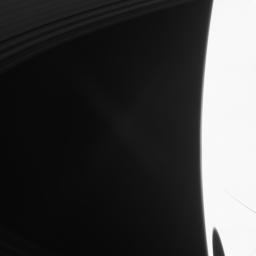The Black Spot
Caption:
A big shadow from Saturn's largest moon darkens the planet in the lower right of this image taken shortly after Saturn's August 2009 equinox.
Titan, the shadow caster, is not shown. The planet is overexposed in this image because the camera's long exposure time was set to show the rings which are dimly lit at equinox. The transparent D ring, which stretches from the middle of the image to the left, is not visible, but the C ring can be seen in the upper left of the image. The excess brightness in the middle of the image is lens flare, an artifact resulting from light being scattered within the camera optics.
Saturn's rings, which are 10 to 100 meters (30 to 300 feet) thick for the most part, cast a narrow shadow onto the planet.
The novel illumination geometry that accompanies equinox lowers the sun's angle to the ringplane, significantly darkens the rings, and causes out-of-plane structures to look anomalously bright and cast shadows across the rings. These scenes are possible only during the few months before and after Saturn's equinox, which occurs only once in about 15 Earth years. Before and after equinox, Cassini's cameras have spotted not only the predictable shadows of some of Saturn's moons (see
PIA11657
), but also the shadows of newly revealed vertical structures in the rings themselves (see
PIA11665
).
This view looks toward the northern, sunlit side of the rings from about 11 degrees above the ringplane.
The image was taken in visible light with the Cassini spacecraft narrow-angle camera on Aug. 19, 2009. The view was obtained at a distance of approximately 2.3 million kilometers (1.4 million miles) from Saturn and at a Sun-Saturn-spacecraft, or phase, angle of 116 degrees. Image scale is 13 kilometers (8 miles) per pixel.
Background Info:
The Cassini-Huygens mission is a cooperative project of NASA, the European Space Agency and the Italian Space Agency. The Jet Propulsion Laboratory, a division of the California Institute of Technology in Pasadena, manages the mission for NASA's Science Mission Directorate, Washington, D.C. The Cassini orbiter and its two onboard cameras were designed, developed and assembled at JPL. The imaging operations center is based at the Space Science Institute in Boulder, Colo.
For more information about the Cassini-Huygens mission visit
http://saturn.jpl.nasa.gov/
. The Cassini imaging team homepage is at
http://ciclops.org
.
Cataloging Keywords:
| Name |
Value |
Additional Values |
| Target |
Titan |
D Ring, Saturn, Saturn Rings |
| System |
Saturn |
|
| Target Type |
Satellite |
Planet, Ring |
| Mission |
Cassini-Huygens |
|
| Instrument Host |
Cassini Orbiter |
|
| Host Type |
Orbiter |
|
| Instrument |
Imaging Science Subsystem (ISS) |
|
| Detector |
Narrow Angle Camera |
|
| Extra Keywords |
Grayscale, Shadow, Visual |
| Acquisition Date |
|
| Release Date |
2009-09-22 |
| Date in Caption |
2009-08-19 |
|
| Image Credit |
NASA/JPL/Space Science Institute |
| Source |
photojournal.jpl.nasa.gov/catalog/PIA11585 |
| Identifier |
PIA11585 |

 Planetary Data System
Planetary Data System
